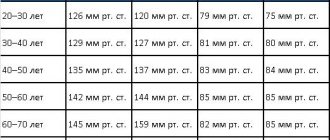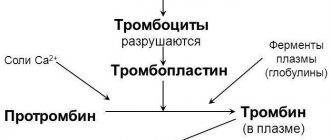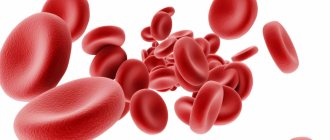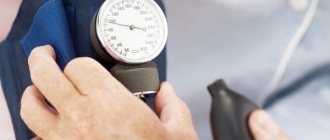The normal pulse rate for women aged 18 years and older corresponds to the heart rate, it is rhythmic, and at rest varies from 60 to 100 beats per minute. When the physiological state changes (sleep, walking, running), heart rate norms for women differ from those observed at rest. In our article we will present the average normal values of heart rate (HR), and, consequently, the normal heart rate in women by age when measured at rest and during exercise.
Why do you need to measure your pulse?
Measuring your pulse is a fairly accurate way to assess the condition of your blood vessels and heart. Both excessive deceleration and strong acceleration of the heart rate lead to insufficient blood ejection into the aorta and the appearance of oxygen deficiency. This condition is manifested by shortness of breath, weakness, sweating, dizziness, and a feeling of chilly limbs.
Therefore, before visiting a doctor, it is recommended to regularly measure your pulse for several days and record it, indicating the time and degree of activity:
- in a dream;
- at rest;
- while walking;
- when climbing stairs and so on.
This will help the specialist understand how pronounced the abnormalities in the functioning of the heart are, because some pathologies in the body can manifest themselves, for example, only during sleep, and others when climbing a flight of stairs.
By giving your body a load, you can determine your level of physical fitness and calculate your heart rate to increase endurance:
- when running and swimming;
- cycling;
- exercises in the gym and so on.
Women's heart rate is on average higher than men's. This is due to the peculiarities of the nervous and hormonal regulation of the heart.
The number of pulse waves can be easily determined at home using the following methods:
- put two fingers on the wrist, feel the pulsation, count the number of beats in 20 seconds and multiply by three;
- measure pressure using a semi-automatic or automatic tonometer, which will also determine the pulse value.
How to properly place your fingers on your wrist when measuring your pulse?
With age, heart rate values gradually decrease. An excessively rapid heartbeat in older people can be one of the signs of various diseases - from anemia to heart failure.
Rhythm
Normally, the intervals between heartbeats should be the same. This pulse is called rhythmic. Normally, a person should not feel the heartbeat at rest. If you can feel your heart beating, the person may have an arrhythmia.
It is manifested by the loss or appearance of extra beats, an increase or decrease in the intervals between them. With arrhythmia, the heart seems to freeze or, conversely, begins to beat too quickly. Arrhythmia can be determined using an ECG.
The most commonly diagnosed are extrasystolic arrhythmia (extrasystole) and atrial fibrillation.
Extrasystolic arrhythmia is the appearance of extra heart contractions. Patients complain of a feeling of cardiac arrest, weakness, and dizziness. This phenomenon is typical for a number of diseases. These include cardiac malformations, VSD, and ischemia. Extrasystoles may indicate the presence of pathologies of internal organs and occur due to abuse of tobacco products. Isolated occurrences of extra heartbeats occur in healthy people, but regular extrasystoles are a reason to consult a doctor. Atrial fibrillation or atrial fibrillation is characterized by a pulse deficit. With this pathology, the heart rate does not coincide with the pulse. Atrial fibrillation is caused by chaotic twitching of the atria. Because of this, the ventricles of the heart cannot contract synchronously and at the same rhythm.
Atrial fibrillation can be episodic, long-term or chronic. If the pathology occurs sporadically, it may go away on its own. People with long-term (more than a week) and chronic atrial fibrillation require drug therapy - taking beta1-blockers. Also, a special procedure is used to restore the heart rhythm - ablation or ablative destruction. It involves applying electric current to the pathological area.
For severe arrhythmia that cannot be treated, the patient is advised to undergo surgery to install a pacemaker or portable defibrillator.
Heart rate norms at rest
The normal heart rate values at rest are individual for each woman and fluctuate throughout the day. With regular measurements, each patient can determine the normal baseline resting heart rate level, which is recorded most often when she is healthy and calm. Deviations from these values may be a reason to contact a therapist.
An adult's pulse should normally be regular. It is acceptable to slightly slow down during a deep breath. Any interruptions and pauses should be a reason to contact a cardiologist.
In the morning
Women should measure their pulse at rest in the morning after waking up, without getting up or turning around in bed.
Table by age in the morning at rest:
| Woman's age | Normal heart rate (beats per minute) |
| 20 – 29 years old | 56 – 66 |
| 30 – 39 years old | 55 – 65 |
| 40 – 49 years old | 54 – 64 |
| 50 – 59 years old | 53 – 63 |
| 60 years and older | 52 — 62 |
Of course, these indicators for each individual person may be higher; Therefore, you should still focus not on the average table indicators, but on your usual heart rate in the morning. It is worth paying attention that if in the morning it is above 80 per minute, it should be monitored not only at rest, but also in other conditions (when running, squats, climbing stairs). This will help identify a possible developing disease in the body.
During the day
The pulse rate in women during normal activity during the day is slightly higher than when measured immediately after waking up, and there are natural reasons for this: periods before, during, after meals and changes in the activity of motor functions.
Table of normal heart rate by age during the day:
| Age category | Normal heart rate (beats per minute) |
| 20 – 25 years old young girls under 29 years old | 70 – 80 |
| 30 – 35 years old, middle-aged women up to 39 years old | 76 – 86 |
| 40 – 45 years old women in adulthood up to 49 years old | 75 – 85 |
| 50 – 55 years old women up to 59 years old | 74 — 84 |
| from 60 years and older, elderly women | 73 – 83 |
When carrying out daily ECG monitoring, heart rate is determined constantly, including during sleep. This is an important indicator, which in any case should not be less than 40 for a healthy woman.
At night
During sleep, a healthy person naturally slows down all physiological and biochemical processes with a decrease in the body's response to stimuli. Heart rate in this state differs from morning and afternoon in lower rates.
The normal heart rate during sleep is calculated taking into account the average values obtained during measurements over the entire night.
Table of norms by age in sleep:
| Woman's age | Normal heart rate (beats per minute) |
| 20 – 29 | 56 – 66 |
| 30 – 39 | 58 – 68 |
| 40 – 49 | 57 – 67 |
| 50 – 59 | 56 – 66 |
| 60 or more | 55 – 65 |
In young women, the heart rate slows down during sleep due to the pronounced slowing effect of the vagus nerve, and in older women - due to a physiological decrease in the activity of the sinus node.
Palpitations during pregnancy
The body undergoes many hormonal changes during pregnancy. Against this background, the heart rate increases, and sometimes physiological tachycardia occurs. There is nothing dangerous about this; an increase in heart rate is just one of the basic symptoms of pregnancy.
The change in heart function is most noticeable in the first months of pregnancy - the pulse increases to 100, sometimes 110 beats.
But after the 13th week of the period, the frequency decreases
. Another jump to 100 beats occurs in the last trimester: the volume of blood transferred increases, the heart contracts more intensely.
The figures given are typical for girls with normal heart rates before pregnancy. If before its onset there was an increased heart rate and disturbances in the functioning of the main organ, the third trimester is often difficult. Late toxicosis may appear: it is more complex than early toxicosis and is accompanied by large jumps in heart rate.
Don't be afraid of such leaps
- with the birth of the child, the body will gradually return to its previous state, the heart will return to its usual rhythm. Typically, the recovery process occurs within 1.5-2 months after childbirth.
If, during pregnancy, the beat rate reaches 115 every minute or higher, you should not neglect this and it is better to make an appointment with a cardiologist. There are cases when a doctor is present at a patient’s birth in order to protect the condition of the mother and child due to possible surges.
Normal heart rate during physical activity
During physical activity, the heart rate naturally increases; the heart muscle must provide the body’s growing needs with the required amount of blood and oxygen. The degree of increase in heart rate will depend on the individual characteristics of the body and the level of training for each individual woman.
But in medicine there is such a definition as the maximum permissible, or proper (submaximal) heart rate rate during running, walking and other physical activity.
When determining the maximum and submaximal heart rate norms, gender differences are not taken into account.
Maximum
The maximum frequency is a value above which even a healthy person may experience oxygen deficiency in the heart muscle. To prevent this condition, a functional atrioventricular block may automatically occur in the heart, with the frequency of contractions of the ventricles of the heart halving. Reaching your maximum heart rate in normal life is not recommended under any circumstances.
It is determined by the simple formula 220 - age in years. For example, for a 60-year-old woman, the critical value would be 220 – 60 = 160 beats per minute.
Submaximal
Submaximal (proper) frequency is a heart rate indicator that is 75% of the calculation of the maximum load of the body. It is also called due. This is the highest safe heart rate value that is recommended during physical activity.
Table by age with the upper limit of normal heart rate in women during exercise (submaximal norm):
| Woman's age | Pulse (beats per minute) |
| 20 – 29 years old | 143 — 150 |
| 30 – 39 years old | 135 – 143 |
| 40 – 49 years old | 128 – 135 |
| 50 – 59 years old | 120 — 128 |
| 60 years and older | Less than 120 |
When walking
During physical activity, it is not at all necessary to reach submaximal heart rate values, since this is the upper limit of the norm.
The normal heart rate when walking is about 60% of the submaximal heart rate.
Heart rate table for women by age when walking:
| Woman's age | Pulse (beats per minute) |
| 20 – 29 years old | 86 – 90 |
| 30 – 39 years old | 81 – 86 |
| 40 – 49 years old | 77 — 81 |
| 50 – 59 years old | 72 — 77 |
| 60 years and older | 68 — 72 |
When running
When running, the heart rate can increase to 75–85% of submaximal and higher. It must be remembered that exceeding the required heart rate does not train the heart, but only creates a dangerous condition for it.
Normally, during running, only a short-term increase in heart rate to a submaximal value is permissible.
Table of heart rate when running by woman’s age:
| Woman's age | Pulse (beats per minute) |
| 20 – 25 years to 29 | 114 — 120 |
| 30 – 35 years to 39 | 108 – 114 |
| 40 – 45 years to 49 | 102 – 108 |
| 50 – 55 years to 59 | 96 – 102 |
| 60 years and older in the elderly | Less than 96 |
Advice from a cardiologist
All of the listed heart rate indicators for women are averaged, that is, in each individual case they can vary significantly. You should know your heart rate to determine whether the body is receiving enough oxygen and nutrients. Therefore, when determining your own load tolerance threshold, you need to focus on your well-being.
If it is easy to measure your heart rate at rest on your own, then to monitor your heart rate during sports it is better to use special devices, for example, fitness trackers.
Many of them allow you to count your pulse during a short stop or even directly during exercise. However, you can also use the usual method of counting pulse waves on the wrist.
When walking, running, or climbing stairs, there should be no significant shortness of breath, dizziness, weakness in the legs, chest pain or other unpleasant symptoms. If they occur during a woman’s usual activity, that is, she cannot walk quickly or climb to the 3rd or 4th floor without shortness of breath, she first of all needs to consult a therapist, and, if necessary, a cardiologist, pulmonologist, hematologist, endocrinologist and other specialists .
Characteristics of heart rhythm and their meaning
When measuring the pulse to assess myocardial function, frequency and rhythm are taken into account.
Frequency
Frequency is the number of heartbeats per unit of time. Pulse can be measured at rest or under load. The average for adults aged 18 to 50 years is 60-80 beats per minute. Deviations from the norm in greater and lesser directions are called tachycardia and bradycardia.
Tachycardia
If the resting heart rate exceeds 100 beats/min, this phenomenon is called tachycardia. It can occur due to pathology and natural causes. A rapid heartbeat at rest in healthy people is observed when the temperature rises, in a stressful situation, due to overwork, when in a hot and humid room, or a sudden change in body position. Pathological causes of tachycardia are associated with diseases of the cardiovascular system, endocrine disorders, alcohol and drug addiction, diseases of the nervous system, circulatory disorders, abuse of tobacco products, energy drinks, diuretics, and caffeine-based drugs.
Pronounced tachycardia, in which the pulse rate without load increases to 200-250 beats, indicates serious pathologies, including a pre-infarction state, myocardial infarction. This is a life-threatening condition in which a person needs to see a doctor.
Rapid heartbeat negatively affects the functioning of the heart and overall well-being; it can be accompanied by surges in blood pressure, chest pain, shortness of breath, and a feeling of severe anxiety. Tachycardia requires mandatory diagnosis to determine the cause and select therapy.
Bradycardia
If the heart rate is lower than normal, this phenomenon is called bradycardia. In adults, bradycardia is diagnosed if the heart rate is less than 50 beats per minute. In the absence of heart and other diseases, physiological bradycardia can be diagnosed in well-trained people, professional athletes. With regular exercise, the heart acquires the ability to pump the required volume of blood in fewer contractions.
Also, a rare heartbeat can be observed with hypothyroidism - a deficiency of thyroid hormones. Bradycardia is encountered by patients with coronary heart disease, endocarditis, other heart diseases, disorders of the autonomic nervous system, and chronic diseases of the digestive system. If the acid-base balance is disturbed, the pulse may slow down due to an imbalance of electrolytes. Typically, the patient will have elevated potassium levels.
Also, taking certain types of medications or a state of severe fright or shock leads to a slowing of the pulse. If the heart rate drops to 50 beats per minute or less, this negatively affects well-being and in some cases poses a threat to life. With bradycardia, the patient feels unwell due to weakness, dizziness, nausea, and sweating. In this condition, the blood supply to organs and tissues is disrupted. If the pulse drops below 40 beats per minute, oxygen starvation develops, and the patient may lose consciousness. If there are signs of hypoxia, a person needs medical attention.
To treat bradycardia, medications and physical therapy are used. If the pathology is caused by a congenital defect or heart disease, the issue of installing a pacemaker is considered.
Characteristic deviations for women
There are 3 characteristic reasons for the deviation of the pulse from the norm in healthy women, which are not always taken seriously by them:
- Excess weight (obesity is an official disease in medicine, which is classified by stages).
- Uterine fibroids (a benign tumor that can sometimes cause certain symptoms when it appears).
- Menopause (during this age period, women experience a natural increase in heart rate).
Excess weight
Fat deposits in the area of the internal organs interfere with the normal movement of the diaphragm, a breathing muscle located between the chest and abdominal cavities. As a result, the depth of breathing decreases. If you are overweight, hypoventilation of the lungs and shortness of breath occur even with light exertion.
To compensate for the lack of oxygen, the heart is forced to work faster to provide blood supply to the body. The closer your body weight is to normal, the better your heart functions.
Uterine fibroids
Another condition characteristic only of women is uterine fibroids. This benign tumor often does not cause any symptoms, but is accompanied by heavy menstruation and becomes the cause of chronic posthemorrhagic anemia.
The disease develops gradually, and the woman does not feel any sudden changes in her well-being. However, a constantly rapid pulse becomes a sign of tension in the cardiovascular system, which works in an enhanced mode to compensate for the lack of oxygen in the blood.
Climax
During menopause, women often experience rapid heartbeats, significant changes in blood pressure, sweating, and pain in the heart. Many people do not pay attention to this and do not get treatment. However, modern gynecology offers many means to improve well-being during this period. You shouldn't refuse this opportunity.
A deviation of the pulse from normal values in women can be an early or even the only external sign of many diseases. Paying close attention to your health and regularly measuring this indicator will help you recognize dangerous diseases at an early stage, when their course is reversible.
Restoring normal heart rate
The restoration of the pulse depends on the period of time during which the state of its deviation from normal limits is observed. Of course, preventing its changes will be better than ignoring this symptom until severe pain and surges in blood pressure occur.
Prevention includes several measures:
- good sleep;
- to give up smoking;
- moderate consumption of alcohol and tonic drinks;
- walks in the fresh air on a daily basis.
In case of increased heart rate, a beneficial measure is training aimed at strengthening the cardiovascular system. Particularly beneficial for the heart are workouts during which the nature and degree of load changes.
Working on emotions is of utmost importance for the prevention of heart rate disorders. Try to be less exposed to stress, because it is they that often provoke strokes. If your constant activity causes nervous tension, then regular meditation or yoga classes are recommended to relieve it.










